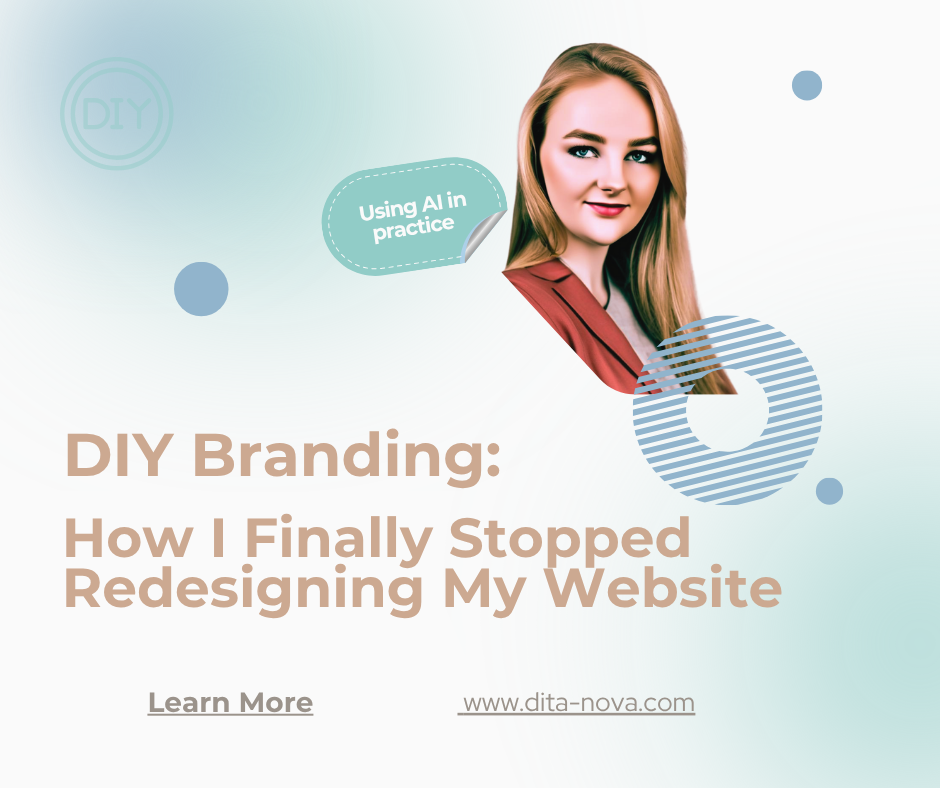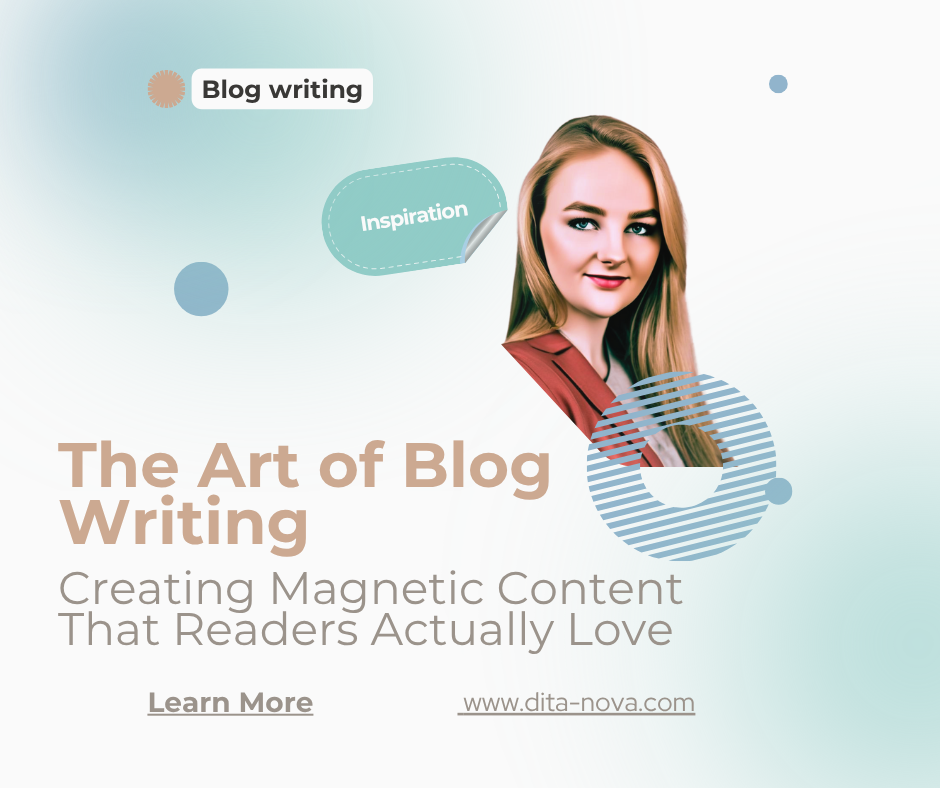Picture this scene: I’m sitting at my computer, redesigning my entire website for the fifth time in two years. Again. Because I just don’t like it anymore. And in a month, I won’t like it again.
Sound familiar? Then we have a problem. And a solution too.
My Endless Redesign Loop (And Why It Never Actually Ended)
If you looked at my website’s history over the past few years, it would look like a schizophrenic portfolio. Pastels gave way to neons, minimalist design morphed into maximalist explosions, fonts changed more often than my mood.
The problem wasn’t that I couldn’t design. The problem was that I was choosing components (colors, fonts) without foundations.
Imagine building a house without an architectural plan. You might have the most beautiful bricks in the world, but without solid foundations, it’ll collapse on your head someday. That’s exactly how my branding worked – pretty to look at, but built on sand.
What Branding Actually Is (And Why It Matters So Much)
For ages, I thought branding = logo + colors + fonts. Done. Then I started asking questions that had never occurred to me before:
- What do I actually want to communicate? (No, “I’m professional” isn’t an answer.)
- Who is my real target audience? (No, “everyone” isn’t an answer either.)
- What values do I represent? (And no, “quality and reliability” sounds like every other entrepreneur.)
- How do I want people to feel when they see my branding?
I’d never properly asked myself these questions. That’s why I kept changing everything – I had no compass to tell me if I was heading in the right direction.
DIY Branding Step by Step: How I Found My Brand
I chose DIY branding not because I was saving money (though that was a nice side benefit), but because I wanted to create something timeless. Something that wouldn’t need changing every six months because it would finally have solid foundations.
Phase 1: Brutal Self-Discovery
I had to answer those questions I’d been putting off for years. And not superficially – really deep. Who am I? What do I offer? Why should anyone care?
(This step hurt more than you want to admit.)
Phase 2: Defining Values and Vision
It’s not about writing pretty phrases for your website. It’s about finding authentic answers that genuinely resonate with who you are and how you work.
Phase 3: Visual Identity with Meaning
Only when I knew WHAT I wanted to say could I dive into HOW to express it visually. Suddenly every color, every font, every design element had its reason.
Tools That Changed My Life (Without Ruining My Budget)
Full confession: I once tried letting ChatGPT handle my ENTIRE brand strategy. The results were… educational, to put it diplomatically.
ChatGPT for strategic thinking: Helped me structure thoughts and ask the right questions. Didn’t replace my brain, but served as an excellent brainstorming partner.
Canva Pro: For about $10 a month, I got access to professional templates and tools that let me realize my vision without learning Photoshop.
Pinterest for inspiration: Instead of mindless scrolling, I started systematically collecting references that resonated with my vision.
My own instincts: The most important tool. I learned to trust them instead of copying trends.
The Results of DIY Branding: What Actually Changed
The biggest change? Confidence. When I know why I made every design decision, I don’t need to constantly doubt and change things.
My branding now feels consistent across all channels because it comes from a clear vision, not momentary mood.
And that feeling when someone tells me: “Your website perfectly captures what you do”? Priceless.
Practical Tip to Get Started
Before diving into any design, you must answer several key questions. Here are the three most important ones you can start with right now:
1. Target Audience
- Who is my audience?
- What challenges and goals do they have?
2. Core Message
- What should people take away?
- Can I summarize my message in one sentence?
3. My “Why”
- Why do I love this?
- What difference do I want to make?

Until you have clear answers to these fundamental questions, any design will just be cosmetic changes without substance.
The Reality of DIY Branding
It won’t be quick. It won’t always be easy. You’ll ask yourself uncomfortable questions and might discover you don’t know some things about yourself.
But the result? Branding that’s truly yours. Timeless, because it’s built on solid foundations. And most importantly – branding you won’t have to change again in six months.
FAQ: Everything You’re Secretly Googling About DIY Branding
What exactly is branding in marketing?
Look, branding in marketing isn’t just slapping your logo everywhere and calling it a day. It’s the entire emotional experience people have with your business. Think of it as your business’s personality – the vibe people get before they even read your “About” page.
Good branding makes people choose you over competitors who offer the exact same thing. Bad branding makes people scroll past you faster than a cringe TikTok.
Can I really do branding design myself?
Absolutely. But (and this is a big but) only if you’re willing to do the unglamorous work first. Most people jump straight to picking colors like they’re decorating a nursery. Wrong move.
DIY branding design works when you’ve nailed the strategy part. Without strategy, you’re just rearranging deck chairs on the Titanic – except the Titanic is your website and the deck chairs are gradient backgrounds.
What makes a good branding company?
A good branding company asks you uncomfortable questions about your business before they even touch Photoshop. If they start with “What colors do you like?” – run.
The best ones make you feel slightly attacked (in a good way) because they’re forcing you to think about things you’ve been avoiding. Like why you started your business and what makes you different from the seventeen other people doing exactly what you do.
Can you show me some branding examples that actually work?
Sure, but here’s the thing – copying someone else’s branding is like wearing their clothes. It might look good on them, but it’ll feel weird on you.
Instead of hunting for examples to copy, study what makes them work. How does their visual identity match their message? How do they make you feel? What story are they telling? That’s the stuff you can actually learn from.
What should be in my DIY branding kit?
Your branding kit isn’t just a folder of pretty files. It’s your brand’s survival guide. Here’s what actually matters:
The Strategy Stuff (the boring but crucial part):
- Your brand values (not the generic ones everyone uses)
- Your target audience (and I mean really specific, not “busy professionals”)
- Your core message in one sentence
The Visual Stuff (the fun part everyone jumps to):
- Templates for social media, business cards, whatever you actually use
- Logo variations that actually work at different sizes
- Colour palette with hex codes (because “that blue-ish color” isn’t helpful)
- Font choices that don’t look like ransom notes
Where can I find DIY branding templates that don’t suck?
Canva Pro is my go-to, but templates are just starting points. If you use them as-is, you’ll look like everyone else who used that same template.
The secret? Use templates as scaffolding, not as the final product. Tweak colors, swap fonts, adjust layouts until it feels like you, not like Template #47.
What are some DIY branding ideas for small businesses?
Stop trying to look like a Fortune 500 company. Seriously. Your personality is your biggest asset, so use it.
Some ideas that actually work:
- Write like you talk (unless you talk like a corporate press release)
- Use your story (everyone has one, even if it feels boring to you)
- Pick one thing you’re genuinely passionate about and weave it through everything
- Show your face (yes, even if you think you’re not photogenic)
How do I know if my branding logo is any good?
Here’s the ultimate test: Show it to your mom. If she can’t immediately tell what you do or it doesn’t feel like “you” to her, it needs work.
A good logo should work when it’s tiny (like favicon-sized) and when it’s huge. It should make sense without explanations. And please, for the love of all things holy, make sure it’s not identical to someone else’s logo. That’s just embarrassing.
What’s the difference between brand kit examples and actual brand kits?
Brand kit examples on Pinterest are like those perfectly staged Instagram homes – pretty to look at, impossible to live in.
Real brand kits are messy, practical, and full of weird edge cases you never thought you’d need. Like what happens when your logo needs to go on a black background, or when someone wants to use it in Comic Sans (spoiler: you say no).
Your brand kit should solve real problems, not just look impressive in your portfolio.



